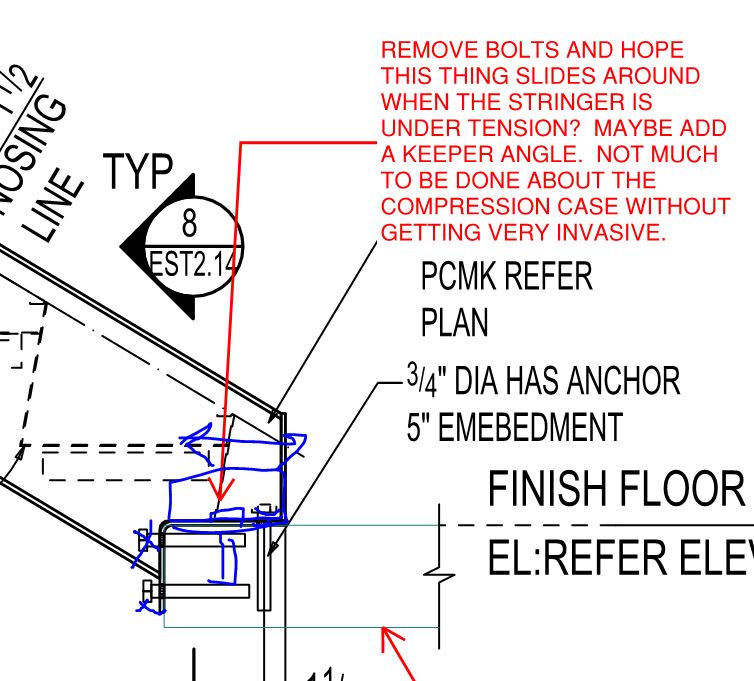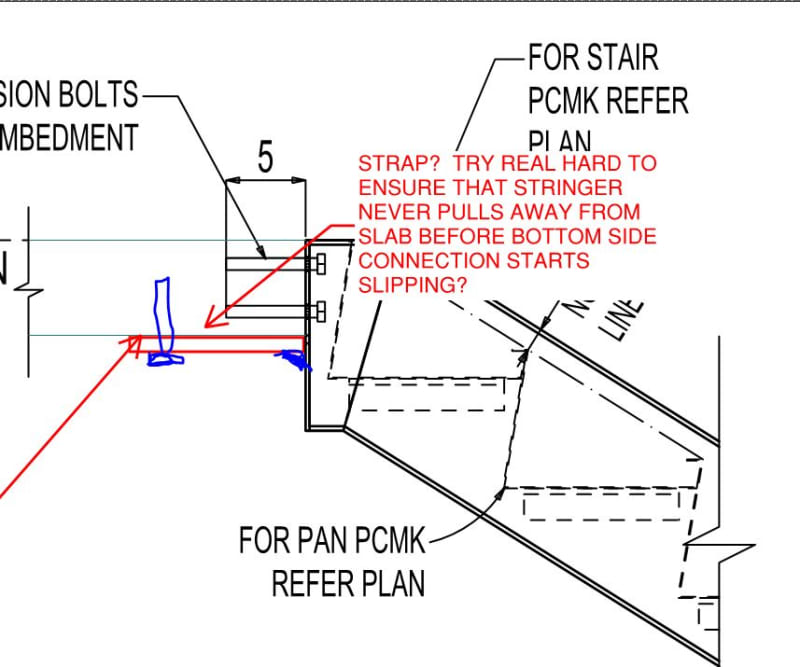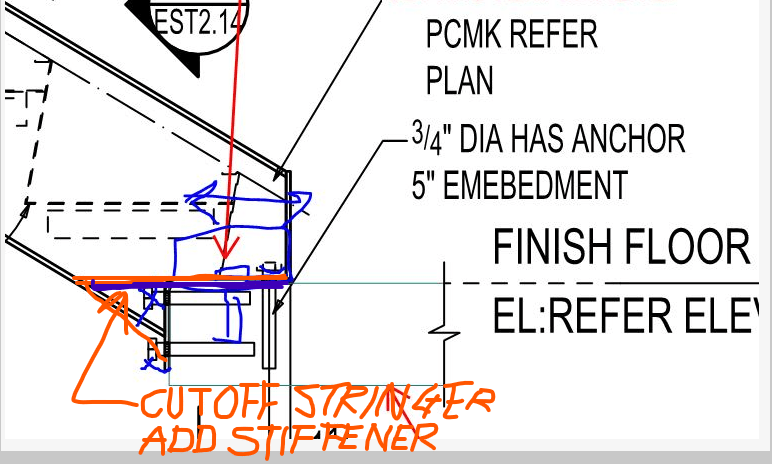I have a project where I was engaged to provide calculations for a set of steel stairs that a fabricator had designed. Being in California, it is important that these stairs satisfy Section 13.5.10 of ASCE 7-16 with connections that can accommodate drift. Unfortunately, these stairs were hard connected into both concrete landings at the top and bottom of the stringers with no slip provisions. Even more unfortunately, these stairs were built long before we were engaged. So, we now have to figure out how to make sure that the stairs are supported should one of their connections, top or bottom, become detached when the floor diaphragms move separately from each other during a seismic event. The concrete landings are thing (6-7.5 inches) and give very little room for an easy anchorage detail, especially when the omega factor is applied. So, has anybody out there dealt with a similar situation? If so, what type of sliding connections have you used to work around the already-constructed stairs. It's quickly getting complicated and I just want to see what other people out there are doing in similar situations. The ASCE provision is new to this edition and I feel like not many people have been taking this into account in their past designs. So, let's chat and see what comes of it. Thanks for your input everybody.
Navigation
Install the app
How to install the app on iOS
Follow along with the video below to see how to install our site as a web app on your home screen.
Note: This feature may not be available in some browsers.
More options
-
Congratulations waross on being selected by the Tek-Tips community for having the most helpful posts in the forums last week. Way to Go!
You are using an out of date browser. It may not display this or other websites correctly.
You should upgrade or use an alternative browser.
You should upgrade or use an alternative browser.
ASCE 7-16, Section 13.5.10 (Steel Stair Sliding Connection)
- Thread starter palves
- Start date
- Status
- Not open for further replies.
This has been coming up with some regularity lately. Do you need to provide a slip connection to prevent the stair from participating laterally? Or do you simply need to ensure that the stairs remain operational under a ULS seismic drift event? Is it accurate to say that if the bottom became detached, it would just slide around and be acceptable? If so, that makes the topside connection going first the only real concern, correct? A top side connection detail would be useful to see if you have it to share.
-Chapter 13.5.10 is valid for the Stairs and Ramps not part of the seismic force-resisting system of the structure to which
they are attached . CHAPTER is for NONSTRUCTURAL COMPONENTS..
- Your statement ' these stairs were hard connected into both concrete landings ' implies, the steel stringers anchored to both landings .
In this case, the Stairs are part of the SFRS and SHALL be included in the structural model. Pls look to the exception (If sliding or ductile connections are not provided to accommodate seismic relative displacements, the stiffness and strength of the stair or ramp structure shall be included in the building structural model of Section 12.7.3....)
How the landings are supported ? Is there a stair well with shear walls ?..Try to see the relative displacements of landings ( storey level and mid height level ). In past , i practiced at high seismic zone and the info. you provided is not enough to see the case..If you provide some details ( structural plan, supporting system of landings, conn. detail of stringers..) you may get more valuable responds..
- Thread starter
- #5
KootK - The latter option is the case. My main reason for wanting a slip connection is to ensure that the stair retains gravity support during a seismic event. The stringers are attached to the side of the 6-7.5" thick concrete landings/floors with (2)-Simpson Strong-Bolts which won't calc. out because there is inadequate edge distance as well as spacing between the bolts. My worry is that these bolts could easily detach from the landing during an earthquake and cause the stairs to collapse. As for your comment about the bottom connection, it is only true in some cases such as when the stair starts at the ground at extends to the 2nd floor. In other cases the stair extends from the 2nd floor to the 3rd floor, so both top and bottom have the potential to separate from the concrete.
HTURKAK - Despite the fact that these stairs are hard connected to both landings (or a SOG and a landing), they were not designed as part of the lateral system. These were a deferred submittal so the EOR didn't need to think much about them. Sure they may actually take load during an earthquake, but I fully expect the connections to detach before before the stringers take any significant lateral load. As for the landings I mentioned, they have various configurations. Sometimes they are intermediate landings and other times they are the actual post-tensioned floor diaphragm.
All- I attached details of both the top and bottom connections for further info. This is for a stringer between the 2nd and 3rd floors so neither connection has room to just slide around should their connection fail.
HTURKAK - Despite the fact that these stairs are hard connected to both landings (or a SOG and a landing), they were not designed as part of the lateral system. These were a deferred submittal so the EOR didn't need to think much about them. Sure they may actually take load during an earthquake, but I fully expect the connections to detach before before the stringers take any significant lateral load. As for the landings I mentioned, they have various configurations. Sometimes they are intermediate landings and other times they are the actual post-tensioned floor diaphragm.
All- I attached details of both the top and bottom connections for further info. This is for a stringer between the 2nd and 3rd floors so neither connection has room to just slide around should their connection fail.
You did not mention for the supporting system of landings.. The contribution of stringers to SFRS are negligible ..however, the stringers will suffer and may detach during an EQ event due to the relative displacements of landings .In order to see the risk of detachment , the stringers shall be included at modelling of SFRS or at least the relative displacements of landings shall be calculated to see the effects.
My experience ( based on witnessing ) , if the intermediate landings supported by columns or walls which are part of SFRS, the relative displacement which the stringer will experience is negligible and so the risk of detach and fall down.
- Thread starter
- #9
KOOTK - Those are all good ideas, but the stairs have already been installed (that happened long before we were involved) and most of the anchors are expansion anchors that can't be removed. Unfortunately we have to work with what's there and add our connections around the existing hardware. Your ideas are similar to things we've come up with so it's good to see that and know we're on the same general wavelength.
HTURKAK - The concrete landings are just the concrete PT floor diaphragms themselves and their basic support system is concrete columns or walls. As for their inclusion in modeling, that ship has sailed as the stairs are a deferred submittal and the EOR for the main structure isn't going to go back and include them now. As for the relative displacement between the floors, I agree that it could be negligible should the stair be located near a solid concrete shear wall. However, if the stair is located in the middle of the floor diaphragm far away from any lateral SFRS elements, there's a possibility for more relative displacement.
However, the fact remains that ASCE 7-16 requires the stairs to be designed to accommodate a minimum displacement of 1/2" so that's what we're trying to work through and detail as best as possible. It's true that we can't do anything about the compressive direction but we're just trying to make sure that they don't lose vertical support should the floors/landings move away from each other. I appreciate the thought you've put into this and will keep plugging away at it.
HTURKAK - The concrete landings are just the concrete PT floor diaphragms themselves and their basic support system is concrete columns or walls. As for their inclusion in modeling, that ship has sailed as the stairs are a deferred submittal and the EOR for the main structure isn't going to go back and include them now. As for the relative displacement between the floors, I agree that it could be negligible should the stair be located near a solid concrete shear wall. However, if the stair is located in the middle of the floor diaphragm far away from any lateral SFRS elements, there's a possibility for more relative displacement.
However, the fact remains that ASCE 7-16 requires the stairs to be designed to accommodate a minimum displacement of 1/2" so that's what we're trying to work through and detail as best as possible. It's true that we can't do anything about the compressive direction but we're just trying to make sure that they don't lose vertical support should the floors/landings move away from each other. I appreciate the thought you've put into this and will keep plugging away at it.
palves said:...and most of the anchors are expansion anchors that can't be removed.
At the low connection, could you pull the nuts off of the two horizontal anchors and cut the base plate away at the one vertical anchor to facilitate some travel?
Dear palves, if i were in your shoes, I will model the whole structure and analysis the system to see the relative movements of the stair landings and take measurements for each separate staircase..
I do not know your scope of work, if only justification of ASCE 7-16 requirement that the stairs to be designed to accommodate a minimum displacement of 1/2" , without knowing the finishing works (tiling etc..) I will suggest ,
i= knowing top connection is weaker than bottom, the disconnection and detach will be at the top.. providing a bracket with spigot connected to the slotted hole of end plate will prevent the falling down .
ii= Take out the horizontal and vertical anchors ( expansion bolt ?..) at bottom connection... drill new slotted hole 2 in. length at bottom plate of stringer and one vertical anchor.
iii= Take out the expansion bolts at top connection , and drill new hole 2 in. diameter with length 12 in. at landing slab. install 1.5 in pipe with epoxy. and use 1.25 in. threaded rod for connection to end plate. ( the rod is axially free to move in socket pipe )..
Note that, options 2 and 3 requires the dismantling of stair arms and you may develop different methods to provide 1/2 in displacements depending on the budget , finishing works ..
Please keep us informed when you decide upon final solution and post the pictures of your solution to help the young fellows..
- Status
- Not open for further replies.
Similar threads
- Replies
- 9
- Views
- 41
- Replies
- 2
- Views
- 15
- Locked
- Question
- Replies
- 3
- Views
- 24
- Question
- Replies
- 10
- Views
- 69
- Replies
- 3
- Views
- 626



